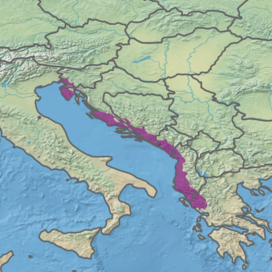Illyrian deciduous forests
| Illyrian deciduous forests | |
|---|---|
 Ecoregion territory (in purple) | |
| Ecology | |
| Realm | Palearctic |
| Biome | Mediterranean forests, woodlands, and scrub |
| Borders | |
| Geography | |
| Area | 39,390 km2 (15,210 sq mi) |
| Countries | |
| Conservation | |
| Conservation status | critical/endangered |
| Protected | 8,855 km2 (22%)[1] |
The Illyrian deciduous forests is a terrestrial ecoregion in southern Europe, which extends along the eastern coast of the Adriatic Sea. It belongs to the Mediterranean forests, woodlands, and scrub biome, and is in the Palearctic realm.
Geography
The Illyrian deciduous forests stretch along the eastern coast of the Ionian and Adriatic Seas, and occupies 40,600 km2 (15,700 sq mi) in Northern Greece, Albania, Montenegro, Bosnia and Herzegovina, Croatia, Slovenia and Northern Italy around Trieste.
The ecoregion is bounded by the Aegean and Western Turkey sclerophyllous and mixed forests (in Greece), Pindus Mountains mixed forests (in Greece and Albania), Dinaric Mountains mixed forests (in Albania, Montenegro, Bosnia and Herzegovina, Croatia, Slovenia and Italy) and Po Basin mixed forests (in Italy).
Climate
The climate of the ecoregion is mostly of Köppen's Mediterranean type with hot summers (Csa) to humid subtropical with wet winters (Cfa).
Flora
Due to the wide altitudinal range of this ecoregion the highest elevations (above 1,000 m (3,300 ft)) are covered with conifer forests, with a mixed broadleaf vegetation and maquis shrubland occurring lower.
The conifer zone is dominated by the
The dominant species of the lower zones include various deciduous oaks
Ecoregion delineation
The Illyrian deciduous forests ecoregion is delineated by the WWF and Digital Map of European Ecological Regions by the European Environment Agency.[2]
External links
- "Illyrian deciduous forests". Terrestrial Ecoregions. World Wildlife Fund.
References
- ^ Eric Dinerstein, David Olson, et al. (2017). An Ecoregion-Based Approach to Protecting Half the Terrestrial Realm, BioScience, Volume 67, Issue 6, June 2017, Pages 534–545; Supplemental material 2 table S1b. [1]
- ^ "Illyrian deciduous forests". Terrestrial Ecoregions. World Wildlife Fund.
